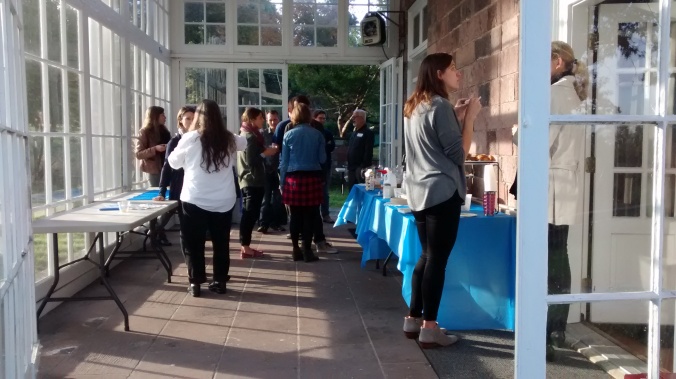Here is a brief report I wrote for the UK Tropical Peatland Working Group (TPWG) blog last week, on the recent C-PEAT meeting convened at Columbia University in New York, for which I was honoured to attend as an early career scientist.
About a month ago, from the 11th to 13th October, 52 scientists met at the Lamont-Doherty Earth Observatory at Columbia University in New York, to discuss peat. The meeting was convened by Zicheng Yu from Lehigh University in Pennsylvania, who was responsible for garnering support for this working group of PAGES. The newly fledged C-PEAT, Carbon in Peat on EArth through Time, aims to bring together peat scientists from across the world and from a range of disciplines, to answer questions about how carbon in peatlands has changed throughout the past and how it might vary into the future. I was fortunate enough to attend the meeting, along with Ian Lawson and various others that have or are still working with the UKTPWG, including Outi Lähteenoja. Here is a brief report of the meeting.

The meeting crew, getting the C-PEAT ball rolling.
The main questions that led discussions during the workshop were:
- Why is there peat?
- How much and how fast can peats accumulate?
- What will happen to peat in the future?
By the end of the three days, I think we were closer to knowing more clearly about what we don’t know, than to actually answering these questions! But we exchanged a huge amount of new information in the process, some of which I’ve reported on below, under each question.
Why is there peat?
We spent one break-out session seeing if we could provide new insights into what the critical controls on peat formation might be. After learning from the talks about the huge range of peatlands present today and during the past, from the diverse forested swamps of Papua New Guinea, to the high-altitude Andean ‘cushion’ peats, to the organic-rich sediments buried under glacial tills in Canada, all with their differing physical parameters, this proved challenging. As did attempts at making generalisations about peat formation through time; time being hundreds of millions of years. One scientist aptly commented that “coal is carbon; peat is water”, which helps to explain part of the picture! There were a number of discussions about deep-time peats and coal, and whether we could make inferences on their development dynamics based on more recent peat formations. A work in progress (by the Deep-time andBuried Peats Thematic Groups).
How much and how fast can peats accumulate?
What are the differences/similarities in peat accumulation rates along different temporal and spatial gradients? Answers on a postcard please. In a very interesting presentation, René Dommain, Smithsonian Institute, presented on tip-up pools in tropical peatland ecosystems and the importance of considering them when interpreting age-depth modelling and peat accumulation dynamics. Rene’s fieldwork focused on the coastal peat domes of Brunei, but some other spectacular and more unexpected domes and craters were brought to everyone’s attention:
- A 200m* deep peat deposit in Greece (which I think is in the Drama Plain), and
- The 65m* deep Lynch’s Crater in Australia.
*Numbers not verified – may have passed through multiple Chinese whispers.

Breakfast chats (about peat?!) in the sunshine, at the Lamont-Doherty campus of Columbia University.
What will happen to peat in the future?
Where will new peat formations arise? Where will peats disappear? And where will they persist?
Will bogs persist with greater frequency than fens? Nigel Roulet, McGill University, presented on the greater resilience of bogs compared to fens, with bogs maintaining hydrological independence from the surrounding environment and therefore being more able to resist the potential impacts of climate change. Jeff Chanton, Florida State University, talked about the SPRUCE mega-project he’s involved with, in the Marcell Experimental Forest in Northern Minnesota, which is attempting to monitor how temperate peatlands respond to changes in climate. Watch this space for the release of the experiment’s findings.
Ian Lawson, University of St. Andrews (and key member of the UKTPWG), presented on what we know about the tropical lowland peatlands of the Peruvian Amazon. He also talked about the threats to their persistence, one of which was an unlikely suspect: aboveground carbon maps, which demonstrate the relatively lower standing carbon stocks in peatland areas compared to in terra firme forests, and fail to illustrate their rich belowground carbon store. Ian highlighted the danger of these maps being used in land use decision-making in Peru, potentially erroneously directing forest conversion to these carbon rich areas. And these peatlands don’t have the emotive conservation pin-up that their Southeast Asian relatives have.
Steve Frolking, University of New Hampshire, presented an analysis on carbon losses from tropical peatlands under different land use change scenarios into the next 50 years. An interesting desk-based exercise that warns of the strong emissions legacy of the peatland management practices that are pervasive across much of Southeast Asia now.
One major area of peatland that we still know so little about was sadly not represented at the meeting: the peat swamps of Central Africa. Perhaps that gap can be filled by members of this group at the next meeting. There was also a distinct lack of anyone named Pete there.
As we move into the Anthropeatscene (!), we need to consider exactly what and where the threats to peatland persistence are. And what the opportunities are for peatland conservation. I’m sure everyone is aware of the fires that have been raging in Indonesian peatlands over the last few months (if not, look at this and this previous post), exacerbated to a great degree by unsustainable peatland management. One big question the workshop considered was: what unique contribution can C-PEAT make as a group to peatland science and conservation, in both the tropical and temperate zone?
If you have the answer, or indeed any answers to the questions above….or are working on them, do join the C-PEAT mailing list by signing up here.